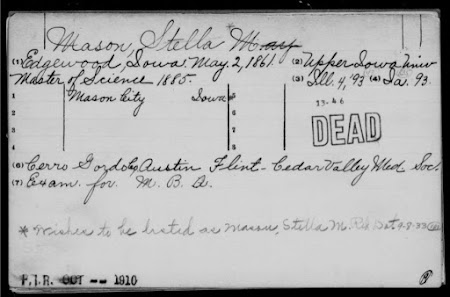Finding Female Ancestors in Unexpected Places
 |
| BPL's Southern History Department has resources to help you find female ancestors. |
By Mary Beth Newbill| Central Library's Southern History Department
As we celebrate Women’s History Month, I thought it would be interesting to take a look at some lesser-known sources for finding our female ancestors. Women can be notoriously difficult to locate in historical records thanks to name changes and social structures that limited their involvement and representation in the wider world. However, there are some wonderful resources that can be a great addition to your took-kit and can provide details about the elusive women that came before us. Travel to faraway places may be easier and faster now that at any point in history, but our ancestors could and did travel. Passports were not required for international travel until the mid-twentieth century, but they were recommended. Luckily, those passport applications have been digitized and can be viewed online.Because early passports were only good for about two years, people who frequently left the country may have multiple applications giving you a detailed summary of their travels. Take the case of Dr. Stella Mason. Dr. Mason lived in Iowa and traveled extensively in the early 1920’s. She applied for two passports, once in 1920 and again in 1925. Both applications include her place of birth, a physical description and photograph, and a long list of countries to be visited. Dr. Mason must have been an extraordinary person. Not only was she one of the first female physicians in her part of the country, but her travels suggest she had a strong sense of adventure and a desire to see the world and did not let her status as an unmarried woman stand in her way. While Dr. Mason’s travels may not be typical, women did travel internationally and their passport applications can be valuable genealogical tools, listing information like their date and place of birth, marital status, father’s name, etc. Keep in mind, however, that not all women had their own passport application. Sometimes women were included on the application of their husband or father if they were traveling together.
Yearbooks can also be useful for identifying educators. They are, of course, mostly associated with students, but teachers and support staff are often listed and many are pictured. The Birmingham Public Library’s collection of local yearbooks has been digitized and can be viewed online. If you need a yearbook from another city or state, Ancestry.com has a huge collection that includes schools from every state and the territories of the United States. If you don’t find what you’re looking for on Ancestry or just want to make sure all your bases are covered, the Internet Archive is a great source for yearbooks. Although I don’t find Internet Archive to be as user-friendly as Ancestry, I have found yearbooks there that I didn’t find anywhere else.
Speaking of doctors, if your ancestor or other female relative practiced a profession like medicine, education, or the law, don’t forget to check any available professional directories. Ancestry.com has the Directory of Deceased American Physicians, 1804-1926 and FamilySearch.org has the U.S. Deceased Physician File, 1864-1968. Guess who I found? Dr. Stella Mason! Each entry includes the person’s age, date and place of death, and information about their medical education. If the legal profession runs in your family, you may be able to learn more about them by viewing a directory called Martindale-Hubbell. Historic volumes of this directory are available on a legal database called Hein Online. This database is usually not available in public libraries but can be found in law firms and law libraries.
Of course, education is one of the few professions that have long been open to women. Many school systems regularly published directories listing all the teachers and support staff. The Birmingham Public Library has a large collection of school directories for Birmingham and Jefferson County which have recently been added to our digital collections.
 |
| High school yearbooks can help you identify educators. |
Yearbooks can also be useful for identifying educators. They are, of course, mostly associated with students, but teachers and support staff are often listed and many are pictured. The Birmingham Public Library’s collection of local yearbooks has been digitized and can be viewed online. If you need a yearbook from another city or state, Ancestry.com has a huge collection that includes schools from every state and the territories of the United States. If you don’t find what you’re looking for on Ancestry or just want to make sure all your bases are covered, the Internet Archive is a great source for yearbooks. Although I don’t find Internet Archive to be as user-friendly as Ancestry, I have found yearbooks there that I didn’t find anywhere else.
I hope these sources will inspire you to start thinking about your female ancestors and what their lives were like. Many, many women’s lives and contributions are waiting to be uncovered. Sometimes it’s just a matter of checking a new resource or thinking about an old one in a different way.
Comments